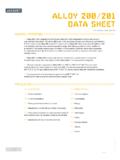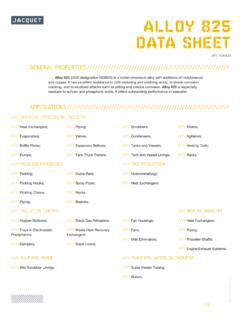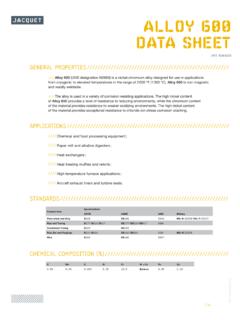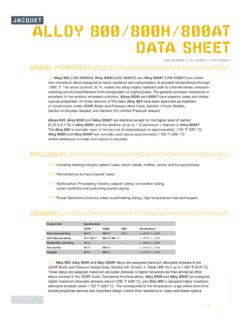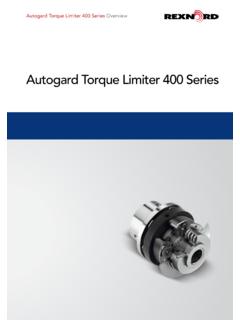Transcription of ALLOY 400 DATA SHEET - Jacquet Metal Service
1 1 / 5 For internal use 400 data SHEETUNS N04400//// ALLOY 400 (UNS designation N04400) is a nickel-copper solid solution ALLOY with high strength over a wide temperature range. It can only be hardened by cold working. The ALLOY has excellent resistance to a variety of corrosive environments from mildly oxidizing through neutral and in moderately reducing conditions. ALLOY 400 also performs well in marine and other nonoxidizing chloride ALLOY 400 was one of the first nickel alloys , its history dating back to the original nickel-copper ore mined in Canada in the late nineteenth century. The composition of the original ore is roughly what the chemistry for ALLOY 400 is As with commercially pure nickel, ALLOY 400 is low in strength in the annealed condition and is consequently offered in a variety of tempers which increase the strength of the Vales and pumps ;//// Pump and propeller shafts ;//// Marine fixtures and fasteners ;//// Chemical processing equipment ;//// Gasoline and fresh water tanks ;//// Crude petroleum stills ;//// Process vessels and piping ;//// Boiler feedwater heaters.
2 //// Heat PROPERTIES //////////////////////////////////////// //////////////APPLICATIONS //////////////////////////////////////// //////////////////////STANDARDS //////////////////////////////////////// ////////////////////////Product formSpecificationsASTMASMEAMSM ilitaryPlate SHEET and Pipe and TubingB163 / B165SB163 / SB1654574 MIL-T-1368 / , Bar and ForgingsB164 / B564SB164 / SB5644675 MIL-T-24106 / / EmICAL CO mPOSITION (%) //////////////////////////////////////// ///////CMnSSiCuNi + max2 / 5 For internal use PROPERTIES //////////////////////////////////////// //////////ConditionYield Strength offsetTensile StrengthElongationElastic Modulus (E)psiMPapsiMPa% in 2"psiGPaAllealed35 00024075 0005204526 x 106180 Hot rolled as rolled45 00031080 0005503026 x 106180 TemperatureYield Strength offsetTensile StrengthElongation F CpsiMPapsiMPa% in 2"702131 00021582 000565482009330 00020580 0005504740020426 00018075 0005204560031625 00017573 0005054680042723 00016070 000480481 00053821 00014553 00037040 TemperatureMean Linear ExpansionbThermal conductivityaSpecific HeataElectric Resistivitya,c F C10-6 in / in / F10-6 cm / cm / CBtu / h-ft- FW / m- KBtu / lb- FJ / kg- K -circ mil / ft.
3 0001 PROPERTIES //////////////////////////////////////// /////////////Th ER mAL PROPERTIES //////////////////////////////////////// //////////////DensityMagnetic PermeabilitySpecific lb / in375 F, 200 oersted Btu / lb- g / cm3430 J / kg- KSpecific GravityMelting F = 2370-2460 C = 1300-1350//// TYPICAL ROOm TEmPERATURE TENSILE PROPERTIES//// ShORT TImE ELEvATED TEmPERATURE PROPERTIESThe following table illustrates the short time tensile properties of ALLOY 400 at temperatures above room temperature. Low temperature properties are added for These values also apply to ALLOY R-405, the free machining version of ALLOY Annealed material. Between 70 F (21 C) and temperature shown. c Annealed material. d Extrapolated3 / 5 For internal use EnvironmentTemperatureCorrosion RateNameMedia & Concentration F CmpyAcetic AcidC2H2O2-All concentrations7021< % % % NaOHBoilingBoiling< % Acid40 % % HCI-No Acid1 % HCI-No Acid5 % HCI-No AcidUp to 10 % HCI8630< Acid12 % Acid25 % HF-Saturated w/ Acid25 % Purged w/ Acid50 % HF-Saturated w/ Acid50 % Purged w/ AcidAnhydrous AcidAnhydrous Fluoride GasHF1 AcidH3PO417680< Acid5 % Acid9 % Acid50 % Acid96 % H2SO45602933 RESISTANCE //////////////////////////////////////// /////////////// ALLOY 400 exhibits resistance to corrosion by many reducing media.
4 It is also generally more resistant to attack by oxidizing media than higher copper alloys . This versatility makes ALLOY 400 suitable for Service in a variety of ALLOY 400 does not perform well in highly oxidizing acids such as nitric or nitrous acids. In such environments, high chromium stainless steels should be considered. //// In moderately reducing acids, neutral or alkaline solutions, ALLOY 400 may be considered for use. The ALLOY is resistant to most alkalies, salts, organic substances and atmospheric conditions. The ALLOY is a consideration for cooler alkaline caustic conditions, although high temperature, high stress and high concentrations of caustic have produced caustic stress corrosion cracking in the material. ALLOY 400 is used in reducing acids such as sulfuric and hydrochloric, especially in the absence of aeration and oxidizing ALLOY 400 is exceptionally resistant to chloride stress corrosion The ALLOY excels applications requiring Service in waters, including sea and brackish ALLOY 400 is attacked in sulfur-bearing gases above 700 F (371 C) and molten sulfur attacks the ALLOY at temperatures over 500 F (260 C).
5 //// AqUEOUS CORROSION DATA4 / 5 For internal use TREATmENT //////////////////////////////////////// /////////////////////// The anneal cycle conducted on ALLOY 400 is typically in the 1 400 F to 1 800 F (760 C to 980 C) range for short times at temperature. The purpose is to soften the material after forming operations while maintaining a relatively fine grain Annealing should be done in an atmosphere as free of sulfur compounds as possible as sulfur will embrittle the material in extended exposure time at the anneal temperature Low temperature stress relief may be conducted on cold deformed material by heating to approximately 575 F (300 C) for 1 to 3 A large percentage of ALLOY 400 is put into Service without a final heat treatment. This is done to increase the strength of the ALLOY 400 exhibits excellent cold forming characteristics normally associated with chromium nickel stainless steels.
6 The ALLOY has a lower work hardening rate than T301 or T304 stainless steel and can be used in multiple draw forming operations where relatively large amounts of deformation occur between ALLOY 400 is softer than many steels in respect to its resistance to hot deformation. Therefore, it can be hot formed into almost any shape. //// The use of proper temperatures is critical when hot forming ALLOY 400. The hot forming temperature range is 1 200 F to 2 150 F. For heavy reductions, recommended Metal temperature is 1 700 F to 2 150 F. For light reductions, the temperature may be taken down to 1 200 F. Working at the lower temperatures produces higher mechanical properties and smaller grain Prolonged soaking at hot working temperatures is detrimental. If a delay occurs during processing, the furnace should be cut back to 1 900 F and not brought up to temperature until operations are resumed.
7 In no case should the ALLOY be heated above 2 150 F as permanent damage may Heavy forging should not be carried out so rapidly that the Metal becomes overheated from working. The use of an optical pyrometer is ALLOY 400 can be readily joined and fabricated. With the proper control of the amount of hot or cold work and by the selection of appropriate thermal treatments, finished fabrications can be produced to a wide range of mechanical //////////////////////////////////////// ////////////////////////// COLD F ORmING//// hOT F ORmING5 / 5 For internal use //////////////////////////////////////// /////////////////////////////// ALLOY 400 may be joined by a variety of processes including gas tungsten-arc, gas Metal -arc and shielded Metal -arc processes. In all of these processes thorough cleaning of the joint area is necessary to avoid embrittlement from such sources as lubricants and paints.
8 The material must be free of scale for best welding//// Welding procedures for ALLOY 400 are similar to those used for austenitic stainless steels. Neither preheating, nor post weld heat treatment are generally required. Joint design is similar to that used for austenitic stainless steels with two exceptions. The first is the need to accommodate the sluggish nature of the molten weld Metal , necessitating a joint design sufficiently open enough to allow fuller filler wire access to fill the joint. The second is the high thermal conductivity and purity of the material which makes weld penetration lower than in austenitic stainless steels.
